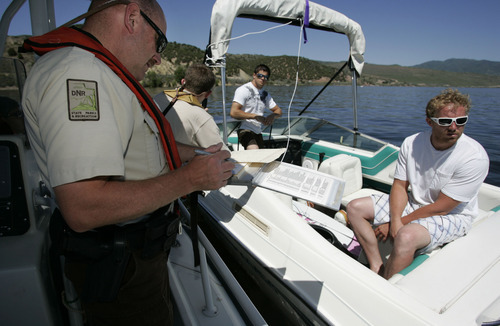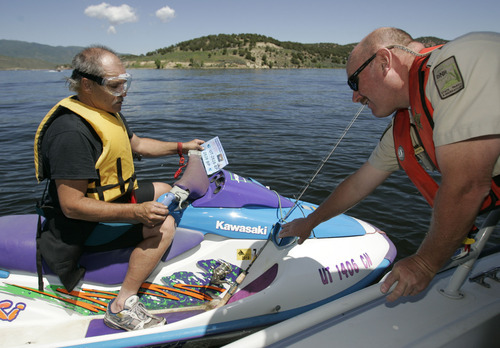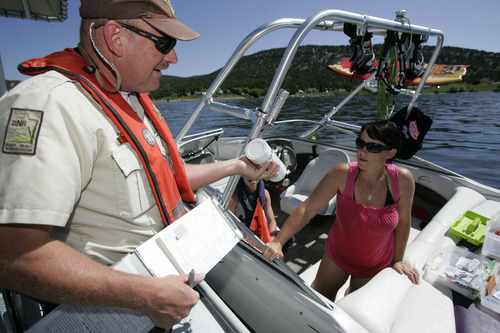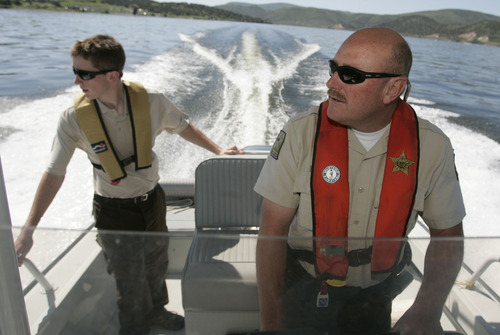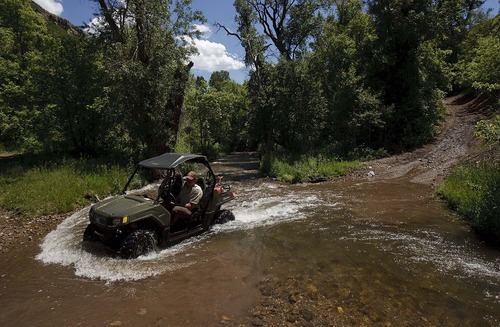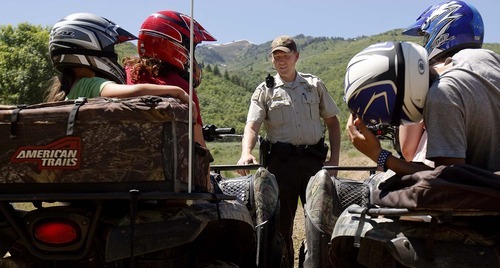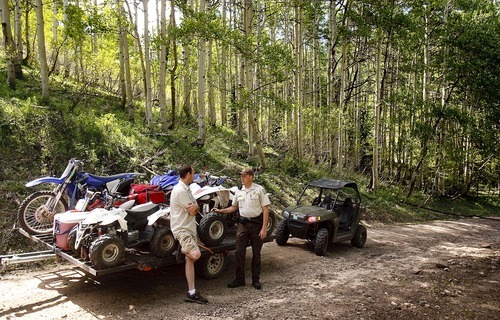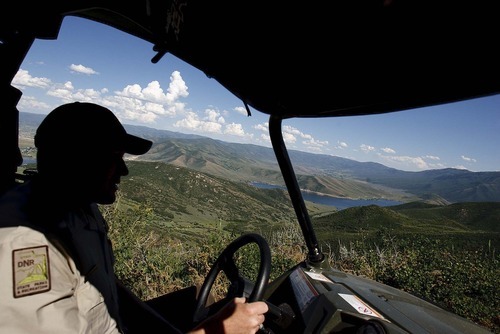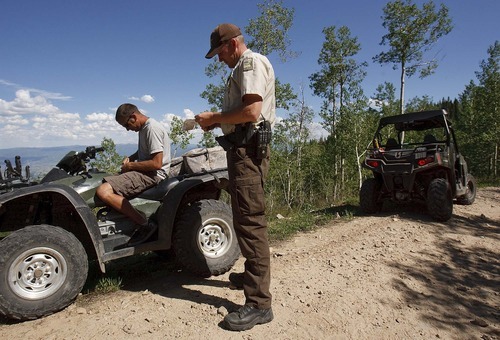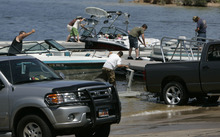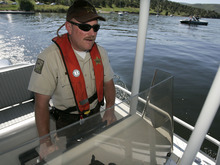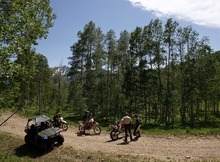This is an archived article that was published on sltrib.com in 2011, and information in the article may be outdated. It is provided only for personal research purposes and may not be reprinted.
When the phone rings at 2 a.m. with reports of an obnoxious group of campers on the shores of Bear Lake, Rich County Sheriff Dale Stacey already feels shorthanded.
Stacey has a staff of four, including himself, and those on duty are stretched thin serving the large Utah county bordering Idaho and Wyoming.
The number of officers available to respond to such calls took a hit on July 1 when mandated budget cuts to Utah State Parks eliminated the law-enforcement capabilities of the Bear Lake State Park manager.
"We get 20,000 to 40,000 people coming to Bear Lake in the summer. There are times when we get calls of 60 to 70 people causing problems in the middle of the night," Stacey said. "If we are really, really lucky, we can get three or four law-enforcement officers to the scene."
Stacey is concerned about how the loss of law enforcement will affect the safety of state park visitors, rangers and local law officers.
"The Utah Legislature has taken one more officer out of the mix," Stacey said. "Losing one officer could be the tipping point between the crowd deciding to remain in control or [someone] deciding to attack you. I can't imagine this is saving them very much money. It is one of those bureaucratic decisions made by someone who hasn't been in that situation before."
Rep. Lee Perry, R-Perry, an officer with the Utah Highway Patrol, is familiar with the help that state parks law enforcement can provide.
"They have been known to help us on occasion when things get crazy on snowy days," he said. "They are a great help."
Perry is concerned about the cuts to law enforcement and is part of a legislative committee formed to study the efficiency of law enforcement in the Department of Natural Resources.
"There was probably a time when state parks was extremely top heavy and overstocked with law enforcement, but pared back even before the most recent budget cuts," Perry said. "Folks on that committee are talking about the fact that it appears we are cutting into the muscle of law enforcement in state parks, that we are cutting to the point of ineffectiveness."
Rural counties across Utah that rely on state parks law-enforcement rangers to help keep the order will face similar situations to Stacey because of the cuts.
Safety inspections and registration checks on boats and off-highway vehicles may also be affected by the cuts, as Utah State Parks is responsible for 1.5 million acres of water and more than 50,000 miles of off-highway trails.
Christopher Quick, chief of law enforcement for Utah State Parks, said his agency has gone from 80 to 59 law-enforcement rangers because of the cuts. Similarly, major cuts to state park law enforcement occurred in 1997, when there was reduction from 121 to 91.
Four of the recent vacancies were created when rangers retired and were not replaced. Another four employees were laid off. The vast majority of the lost law-enforcement officers came in the form of decommission of legal authority, which Quick pointed out is, indeed, not a major savings to the agency.
"The shame is the fact these are people who have spent years and years in training, and we excused them of their law-enforcement abilities not because they were unable to do their jobs, but because the legislative audit told us to reduce law-enforcement positions," he said.
The audit, performed at the request of the Legislature and completed in January, suggested that fewer officers were required because of a low number of citations at state parks.
Quick and Sid Groll, director of law enforcement for the Department of Natural Resources (DNR) over state parks, are not comfortable with cutting positions based on the number of citations handed out.
"There were some valid things pointed out in the audit, but one of the concerns I had personally was that they articulated that only citations be used as a barometer for what rangers should do in a park," Groll said. "The responsibilities of a law-enforcement ranger are far greater than just citations."
The Legislature required Utah State Parks employees by law to "protect the parks, property and visitors," but also to "promote safety and education for persons and property related to boating and off-highway vehicles and to protect the environment connected with the use and operation of off-highway vehicles and vessels."
Secondary obligations of state parks officers include responding as peace officers, providing assistance to local law enforcement and other DNR and public management agencies.
The goal, Quick said, is to make people feel safe while they are recreating and from each other.
"If we wanted to write thousands and thousands of citations, we could do that, but we are not there to discourage people from having a good time," Quick said. "We are here to keep people safe by educating them and helping them when unfortunate events occur."
In addition to witnessing 6,289 violations and writing 4,270 citations in 2010, state parks rangers also helped with 73 search and rescue incidents, assisted in 185 medical cases and had 20 "use of force" incidents.
Perry, as a highway patrolman, believes he can handle ugly situations that can develop in campgrounds, but he knows not everyone is trained to deal with confrontations.
"If I'm going camping with my family, I want someone [else] to handle those situations. There needs to be somebody close who is available to call and respond to the problem," Perry said. "People need to feel safe and protected in state parks."
Quick is concerned that rangers who are still employed by state parks may use the audit and the resulting cuts as a guide and feel compelled to issue more citations, something he will discourage them from doing.
Issuing more tickets may also draw legislative attention. Several years ago the law-enforcement side of the Utah Division of Wildlife Resources was threatened with changes by legislators for being "too heavy-handed."
Another audit suggestion — one that has been around for a while — was to combine the law-enforcement personnel of the Department of Natural Resources (namely Utah State Parks and the Utah Division of Wildlife Resources).
Groll said "there is some logic" in that suggestion, but that specific laws to each agency — there are 93 separate rules applying to the state park system, 125 specific to boating and 35 for off-highway use — have kept the agencies separate. This is why a state park ranger doing a vessel safety inspection doesn't ask to see a fishing license or why a wildlife officer checking on a fishing limit doesn't hand out a ticket for a boat owner not having a youth in a life jacket.
The agencies started sharing the capacity to write citations across the divisions this year as the result of a legislative committee formed to study the efficiency of law enforcement in the Department of Natural Resources.
"It is about limiting the time we take from people recreating," Quick said. "Being contacted once instead of twice. We realize this necessity and it makes sense."
A report from the legislative committee will be presented to legislators in the fall. Perry said he is going to make a suggestion that rangers who have been certified as law enforcement previously be reinstated.
"No money is being saved by taking away those law enforcement duties," Perry said. "If it was going to cost the taxpayers money, I'd maybe feel differently about it, but if they are already there in another capacity and are effective as law officers, I say let them do it."
By the numbers: Utah State Parks law enforcement
2010 summary
6,289 violations
4,270 citations
2,019 written warnings
103 DUI citations
1,997 reports
73 search and rescue incidents
185 medical incidents
900 vessel assists
562 aquatic invasive species inspections
3,758 vessel safety inspections
20 use of force incidents
16 administrative checkpoints
5 pursuit incidents
Source: Utah State Parks for 2010 —
Tribune series: The issues facing Utah's state parks
July 3 • Utah's 43 state parks are reeling from budget cuts, which have slashed general funding from $12.2 million to $6.8 million in recent years.
July 3 • Rock Cliff Nature Center at Jordanelle State Park closed July 1 as a result of budget cuts. Additionally, 23 full-time state parks position were eliminated.
July 11 • Edge of the Cedars Museum, the largest federal depository for artifacts in the Four Corners, is holding on, despite being listed second on the Legislature audit's list of facilities under consideration for closure.
July 12 • Camp Floyd/Stagecoach Inn State Park and Museum has gone from what was essentially a restroom stop into a money-generating venture.


